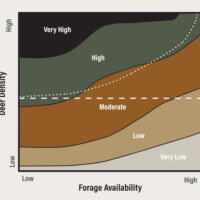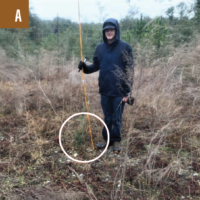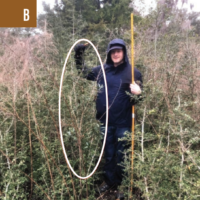 Purdue University - Extension - Forestry and Natural Resources
Purdue University - Extension - Forestry and Natural Resources
Got Nature? Blog
How does forest management affect wildlife, specifically birds? Which birds prefer which types of forest habitat? How can you help birds thrive on your property?
The Forestry for the Birds Virtual Tour is a new tool developed by Purdue Forestry and Natural Resources and Purdue Extension, which offers answers to those questions and more in an easily digestible and visual format. The virtual tour is based on The Nature Conservancy’s Forestry for the Birds program.
The virtual tour is an interactive guide to forest management techniques and birds in the forest that features 360-degree images, including several taken on eight Purdue FNR properties across the state. Bird identification resources from Cornell Lab of Ornithology’s Macaulay Library, forest management resources from Purdue Extension and more make the tour come to life and allow landowners to improve their identification and management skillsets.
The tour was created and is narrated by Kaitlyn Young, a 2022 wildlife alumna and current FNR master’s degree student. Young spent the summer of 2023 monitoring birds as an avian monitoring and extension intern for the Purdue FNR Extension Internship program.
Young conducted breeding bird surveys and made recordings of all the species she encountered whether audibly or visually last summer. She utilized a GoPro Max to capture 360-degree images of the properties she surveyed. Song Meter Mini acoustic monitors allowed her to capture various bird songs, which are incorporated into the background of some of the virtual scenes of the tour. Still camera images also provide stunning visuals of each property and bird type.
“I think my favorite thing about the tour is that when you are exploring each scene, it really feels like you are there,” Young explains. “I want folks who may not be able to visit our properties to feel like they are right there, inside the scene, while learning a thing or two about bird conservation and managing our forests for our rapidly declining feathery friends.”
Young is quick to note, however, that it is much easier to spot the birds she added to each scene of the tour than when trying to look for them during surveys, when they are often hiding behind the leaves in the canopy.
Forestry for the Birds is a project developed by the Indiana Chapter of The Nature Conservancy, which provides foresters and private landowners with the information and tools needed to enhance their forests in a way that fosters thriving bird communities. Many resources, including the Forestry for the Birds pocket guides, focus on the “Birders’ Dozen,” or 12 bird species which nest in the Central Hardwood ecoregion of Indiana that are easy to identify by sight and/or sound, and need conservation action to assist with range-wide or local population declines. The Birders’ Dozen species were selected by The Nature Conservancy and an independent group of birders, ornithologists and conservationists.
The virtual tour focuses on how different forest stewardship practices and forest types can benefit a variety of bird species, including the Birders’ Dozen. In each scene, there are three or more bird species to look for, recorded bird songs which are representative of what you could hear in that scene, interactive icons that link to images and videos and an audio description of the scene.
“I’m excited to see this virtual tour come to fruition – it provides some depth of information to complement the Forestry for the Birds Pocket Guide and Silvicultural Guide,” said Jessica Outcalt, Purdue Extension Educator, who helped develop the Forestry for the Birds materials for TNC. “I especially appreciate the visuals and audio that can’t be communicated via printed materials, and how this tour captures the sense of being in a forest that will make the material accessible to a wider audience.”
The properties shown illustrate a variety of forest stewardship techniques ranging from single tree selection to group tree selection, shelterwood, clearcut, oak woodland restoration and prescribed fire. The tour also highlights both young forests and mature closed-canopy forests.
The Birders’ Dozen includes:
- Yellow-billed and Black-billed Cuckoo
- Eastern Whip-poor-will
- American Woodcock
- Eastern Screech-Owl
- Red-headed Woodpecker
- Wood Thrush
- Eastern Towhee
- Yellow-Breasted Chat
- Baltimore Oriole
- Worm-eating Warbler
- Hooded Warbler
- Cerulean Warbler
*Bird species listed above with links will take you to the Indiana Woodland Steward website as they share highlights with this information in “The Birders’ Dozen Profile” written by Jessica Outcalt.
The American Woodcock, Wood Thrush and Cerulean Warbler are listed on the National Audubon Society watchlist, while the Cerulean warbler is state endangered in Indiana. The Eastern Whip-poor-will, American Woodcock, Worm-eating Warbler and Hooded Warbler have been noted as species of special concern by the Indiana Department of Natural Resources Division of Fish and Wildlife.
To view this article along with other news and stories posted on the Purdue Forestry and Natural Resources website view: Virtual Tour Brings Forest Management for the Birds to Life.
Resources:
Breeding Birds and Forest Management: the Hardwood Ecosystem Experiment and the Central Hardwoods Region, The Education Store, Purdue Extension – Forestry and Natural Resources
Forest Birds, The Education Store
Managing Woodlands for Birds, The Education Store
Managing Woodlands for Birds Video, Purdue Extension-Forestry and Natural Resources (FNR) YouTube Channel
Breeding Birds and Forest Management: the Hardwood Ecosystem Experiment and the Central Hardwoods Region, The Education Store
The Birders’ Dozen, Profile: Baltimore Oriole, Indiana Woodland Steward
Ask An Expert, Playlist, Purdue Extension – FNR YouTube channel
It’s For the Birds, Indiana Yard and Garden-Purdue Consumer Horticulture
Birds and Residential Window Strikes: Tips for Prevention, The Education Store, Purdue Extension resource center
No Room at the Inn: Suburban Backyards and Migratory Birds, Education Store, Purdue Extension resource center
Putting a Little Wildlife in Your Backyard This Spring, The Education Store
Wendy Mayer, FNR Communications Coordinator
Purdue University Department of Forestry and Natural Resources
Deer are an important part of Indiana woodlands and represent a true conservation success story. Many Hoosiers spent time in the woods pursuing deer during hunting season or marveling at them during walks in their woodlands. But as recently as the 1930s deer were absent from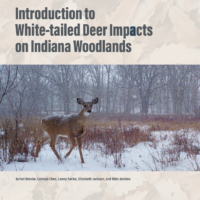 Indiana woodlands. Restocking efforts led by the Indiana Department of Natural Resources helped reestablish deer populations across the state. However, deer populations have rebounded beyond what the land can support in many areas, leading to issues like crop damage, deer-vehicle collisions, and damage to woodlands.
Indiana woodlands. Restocking efforts led by the Indiana Department of Natural Resources helped reestablish deer populations across the state. However, deer populations have rebounded beyond what the land can support in many areas, leading to issues like crop damage, deer-vehicle collisions, and damage to woodlands.
Deer overabundance can pose a threat to the future health of many Indiana woodlands. Deer are considered a “keystone” species, which means their feeding habits (browsing) can shape our woodlands’ look and their plant and wildlife communities. This publication will outline some of the impacts deer can have on Indiana woodlands and what signs and symptoms to look for in your woods.
Learn more about the amount of impact in this new publication:
Low Impact: When deer have little impact on your woodlands, you often see a high diversity of plants. An abundance of preferred species like trillium (picture) can also be a sign of low deer impact.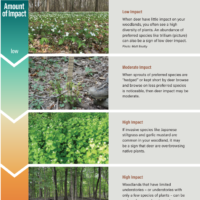
Moderate Impact: When sprouts of preferred species are “hedged” or kept short by deer browse and browse on less preferred species is noticeable, then deer impact may be moderate.
High Impact: If invasive species like Japanese stiltgrass and garlic mustard are common in your woodland, it may be a sign that deer are overbrowsing native plants.
High Impact: If invasive species like Japanese stiltgrass and garlic mustard are common in your woodland, it may be a sign that deer are overbrowsing native plants.
Very High Impact: Browse lines indicate a severe deer problem and appear when deer browse all plants within their reach (<6 feet).
You can read this full publication for free at Introduction to White-tailed Deer Impacts on Indiana Woodlands.
View the Deer Impact Toolbox for more resources and videos.
Resources:
Purdue Extension Pond and Wildlife Management
Introduction to White-tailed Deer Impacts on Indiana Woodlands
Understanding White-tailed Deer and Their Impact on Indiana Woodlands, The Education Store
Monitoring White-tailed Deer and Their Impact on Indiana Woodlands, The Education Store
Managing White-tailed Deer Impacts on Indiana Woodlands, The Education Store
Ask an Expert: Wildlife Food Plots, video, Purdue Extension – FNR YouTube Channel
How to Build a Plastic Mesh Deer Exclusion Fence, The Education Store
Managing Your Woods for White-Tailed Deer, The Education Store
Bovine Tuberculosis in Wild White-tailed Deer, The Education Store
Handling Harvested Game: Episode 1, Field Dressing, video, Purdue Extension – FNR YouTube Channel
Deer Harvest Data Collection, Got Nature? Blog, Purdue Extension – FNR
How to Score Your White-tailed Deer, video, The Education Store, Purdue Extension Resource Center
White-Tailed Deer Post Harvest Collection, video, The Education Store
Age Determination in White-tailed Deer, video, The Education Store
Handling Harvested Deer Ask an Expert? video, Purdue Extension – FNR YouTube Channel
Subscribe to Purdue Extension-Forestry & Natural Resources YouTube Channel, Wildlife Playlist
Jarred Brooke, Wildlife Extension Specialist
Purdue Department of Forestry and Natural Resources
Deer are an essential part of our ecosystems, but the phenomenon of too many deer should be of concern to forest landowners and the public in general. Deer are a “keystone” species, meaning their browsing can impact forest and wildlife communities. It is clear that when deer become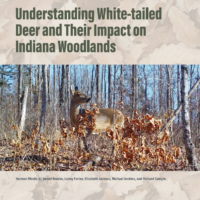 overabundant, their impact on the environment can be problematic. But by understanding the impacts deer have on our woodlands, their food preferences, and how to assess and evaluate impacts in your woodlands, we can begin to address the problems caused by overabundant deer.
overabundant, their impact on the environment can be problematic. But by understanding the impacts deer have on our woodlands, their food preferences, and how to assess and evaluate impacts in your woodlands, we can begin to address the problems caused by overabundant deer.
Learn more about the research and how it can help you and your land:
- Carrying Capacity
- Too Many Deer or Not Enough Food: Managing the Foodscape
- Monitoring Deer and Forest Vegetation
- Food Preferences
- Deer Impact Assessment
- More Resources
To receive the free download and recipe visit the Purdue Extension’s resource center: The Education Store – Understanding White-tailed Deer and Their Impact on Indiana Woodlands.
View the Deer Impact Toolbox for more resources and videos.
Resources:
Purdue Extension Pond and Wildlife Management
Introduction to White-tailed Deer Impacts on Indiana Woodlands
Understanding White-tailed Deer and Their Impact on Indiana Woodlands, The Education Store
Monitoring White-tailed Deer and Their Impact on Indiana Woodlands, The Education Store
Managing White-tailed Deer Impacts on Indiana Woodlands, The Education Store
Ask an Expert: Wildlife Food Plots, video, Purdue Extension – FNR YouTube Channel
How to Build a Plastic Mesh Deer Exclusion Fence, The Education Store
Managing Your Woods for White-Tailed Deer, The Education Store
Bovine Tuberculosis in Wild White-tailed Deer, The Education Store
Handling Harvested Game: Episode 1, Field Dressing, video, Purdue Extension – FNR YouTube Channel
Deer Harvest Data Collection, Got Nature? Blog, Purdue Extension – FNR
How to Score Your White-tailed Deer, video, The Education Store, Purdue Extension Resource Center
White-Tailed Deer Post Harvest Collection, video, The Education Store
Age Determination in White-tailed Deer, video, The Education Store
Handling Harvested Deer Ask an Expert? video, Purdue Extension – FNR YouTube Channel
Subscribe to Purdue Extension-Forestry & Natural Resources YouTube Channel, Wildlife Playlist
Jarred Brooke, Wildlife Extension Specialist
Purdue Department of Forestry and Natural Resources
Wherever deer exist, they will be impacting the ecosystem through browsing. But at what level is that impact considered harmful? Many ecologists consider deer impact harmful when deer begin to reduce plant diversity in a woodland through browsing. knowing the exact number of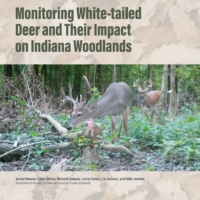 deer on a property is difficult to measure and unnecessary. There are relatively easy ways to estimate the number of deer on a property or track trends in population sizes over time. This publication is written to help woodland owners better understand how to monitor deer and their impact.
deer on a property is difficult to measure and unnecessary. There are relatively easy ways to estimate the number of deer on a property or track trends in population sizes over time. This publication is written to help woodland owners better understand how to monitor deer and their impact.
Monitoring deer impact is done by surveying what deer eat in a forest and how intensively they browse those species. Deer are browsers rather than grazers (like bison and cattle), preferring to eat forbs (broadleaf herbaceous plants), vines, shrubs, and trees rather than grasses. Deer also select specific parts of the plants (e.g., leaves, twigs, and young tender growth).
Monitoring Deer Impact Methods: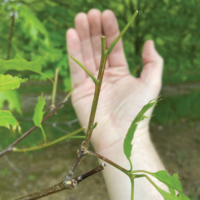
- Browse Surveys
- Indicator Plants
- Assessing Vegetation Impacts from Deer
- Ten-Tallest Method
- Twig-Aging
- Oak Sentinel
- Stump Sprouts
To receive the free download visit the Purdue Extension’s resource center: The Education Store – Monitoring White-tailed Deer and Their Impact on Indiana Woodlands.
Resources:
Purdue Extension Pond and Wildlife Management
Introduction to White-tailed Deer Impacts on Indiana Woodlands
Understanding White-tailed Deer and Their Impact on Indiana Woodlands, The Education Store
Monitoring White-tailed Deer and Their Impact on Indiana Woodlands, The Education Store
Managing White-tailed Deer Impacts on Indiana Woodlands, The Education Store
Ask an Expert: Wildlife Food Plots, video, Purdue Extension – FNR YouTube Channel
How to Build a Plastic Mesh Deer Exclusion Fence, The Education Store
Managing Your Woods for White-Tailed Deer, The Education Store
Bovine Tuberculosis in Wild White-tailed Deer, The Education Store
Handling Harvested Game: Episode 1, Field Dressing, video, Purdue Extension – FNR YouTube Channel
Deer Harvest Data Collection, Got Nature? Blog, Purdue Extension – FNR
How to Score Your White-tailed Deer, video, The Education Store, Purdue Extension Resource Center
White-Tailed Deer Post Harvest Collection, video, The Education Store
Age Determination in White-tailed Deer, video, The Education Store
Handling Harvested Deer Ask an Expert? video, Purdue Extension – FNR YouTube Channel
Subscribe to Purdue Extension-Forestry & Natural Resources YouTube Channel, Wildlife Playlist
Jarred Brooke, Wildlife Extension Specialist
Purdue Department of Forestry and Natural Resources
White-tailed deer are an integral piece of Indiana’s forest ecosystems. When in balance with the ecosystem, deer can enhance the health of the forest. This publication highlights the various tools available to woodland owners for mitigating the impacts of deer on their regenerating trees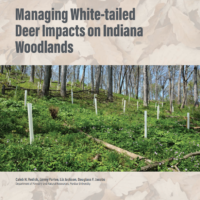 and is based on a compilation of research on the relative effectiveness of various deer browse control methods.
and is based on a compilation of research on the relative effectiveness of various deer browse control methods.
What control methods are available to help with forest regeneration? You will find the answer to this question and more, along with what deer population control means for forest landowners in this publication.
Check out the publications for the “Browse Control Methods for Forest Regeneration and Their Effectiveness” table which includes these control methods: Fencing; Population Control; Tree Shelters; Cages; Companion Plants; Repellents; Timber Harvests; Slash; and Fertilizer.
To receive the free download and recipe visit the Purdue Extension’s resource center: The Education Store – Managing White-tailed Deer Impacts on Indiana Woodlands.
Resources:
Purdue Extension Pond and Wildlife Management
Introduction to White-tailed Deer Impacts on Indiana Woodlands
Understanding White-tailed Deer and Their Impact on Indiana Woodlands, The Education Store
Monitoring White-tailed Deer and Their Impact on Indiana Woodlands, The Education Store
Managing White-tailed Deer Impacts on Indiana Woodlands, The Education Store
Ask an Expert: Wildlife Food Plots, video, Purdue Extension – FNR YouTube Channel
How to Build a Plastic Mesh Deer Exclusion Fence, The Education Store
Managing Your Woods for White-Tailed Deer, The Education Store
Bovine Tuberculosis in Wild White-tailed Deer, The Education Store
Handling Harvested Game: Episode 1, Field Dressing, video, Purdue Extension – FNR YouTube Channel
Deer Harvest Data Collection, Got Nature? Blog, Purdue Extension – FNR
How to Score Your White-tailed Deer, video, The Education Store, Purdue Extension Resource Center
White-Tailed Deer Post Harvest Collection, video, The Education Store
Age Determination in White-tailed Deer, video, The Education Store
Handling Harvested Deer Ask an Expert? video, Purdue Extension – FNR YouTube Channel
Subscribe to Purdue Extension-Forestry & Natural Resources YouTube Channel, Wildlife Playlist
Jarred Brooke, Wildlife Extension Specialist
Purdue Department of Forestry and Natural Resources
White-tailed deer are an important part of our Hoosier natural areas and a true conservation success story. Once extirpated from Indiana, deer now thrive in all 92 counties.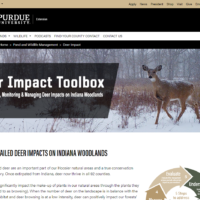
Deer can significantly impact the make-up of plants in our natural areas through the plants they eat (referred to as browsing). When the number of deer on the landscape is in balance with the available habitat and deer browsing is at a low intensity, deer can positively impact our forests’ plant diversity. When deer are overabundant, their browsing can impact forests in a variety of negative ways.
5 Steps to address deer impacts to Indiana Woodlands:
Understanding
Understand how deer impact Indiana’s forest ecosystems.
Identify
Identify signs and symptoms of deer impact in your woodland.
Monitor
Monitor how deer are impacting your woodland over time.
Manage
Decide how to manage deer and their impact on your woodland.
Evaluate
Evaluate if the management actions you took reduced deer impact on your woodland.
Check out the new Deer Impact Toolbox website for publications and more details to discover the steps landowners and land managers can take to understand, monitoring, and manage deer impacts to Indiana’s forests.
Don’t miss the videos: Monitoring Deer Impacts on Indiana Forests: Ten-Tallest Method and Monitoring Deer Impacts on Indiana Forests: Accessing Vegetation Impacts for Deer (AVID) Plots.
Check out the College of Agriculture news article to learn more: Deer Impact Toolbox provides guidance for Indiana forest landowners and managers.
Resources:
Purdue Extension Pond and Wildlife Management
Understanding White-tailed Deer and Their Impact on Indiana Woodlands, The Education Store
Monitoring White-tailed Deer and Their Impact on Indiana Woodlands, The Education Store
Managing White-tailed Deer Impacts on Indiana Woodlands, The Education Store
Ask an Expert: Wildlife Food Plots, video, Purdue Extension – FNR YouTube Channel
How to Build a Plastic Mesh Deer Exclusion Fence, The Education Store
Managing Your Woods for White-Tailed Deer, The Education Store
Bovine Tuberculosis in Wild White-tailed Deer, The Education Store
Handling Harvested Game: Episode 1, Field Dressing, video, Purdue Extension – FNR YouTube Channel
Deer Harvest Data Collection, Got Nature? Blog, Purdue Extension – FNR
How to Score Your White-tailed Deer, video, The Education Store, Purdue Extension Resource Center
White-Tailed Deer Post Harvest Collection, video, The Education Store
Age Determination in White-tailed Deer, video, The Education Store
Handling Harvested Deer Ask an Expert? video, Purdue Extension – FNR YouTube Channel
Subscribe to Purdue Extension-Forestry & Natural Resources YouTube Channel, Wildlife Playlist
Jarred Brooke, Wildlife Extension Specialist
Purdue Department of Forestry and Natural Resources
Purdue Extension: This Purdue Extension 2023 Impact Report features stories that highlight partnerships that have served our state’s producers, supported residents in becoming healthier, built more resilient communities and prepared Indiana’s youth to take that first step to their giant leap. We will continue to bring the science, technology and resources to all 92 counties as Indiana’s educational partner for life and as an extension of the world class institution we represent: Purdue University.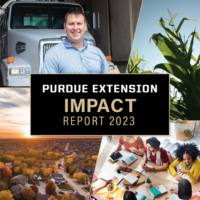
Check out the Purdue Extension-Forestry & Natural Resource highlights on the following programs:
- Todays Teens Lead the Way in Sharing Love of STEM
- Guiding Farm Families Down the Road of Succession Planning
- Providing Support for Families Through Seasons of Change
- Addressing Substance Use Recovery Together
- Workforce Development Efforts Target a Broad Range of Users
- Training International Farmers in Food Preservation and Processing
- Farmer-Driven Research Creates Solutions
Resources:
Nature of Teaching, Purdue College of Agriculture
Community Development, Purdue Extension
Purdue Extension
Family Programs, Purdue Extension – Health and Human Sciences
Taking Action to Address Substance Use in Communities (TASC), Purdue Extension
Diversified Farming and Food Systems, Purdue Extension
Woodland Stewardship for Landowners, Playlist, Purdue Extension – Forestry and Natural Resources YouTube channel
A Woodland Management Moment, FNR – Ext Playlist
Hardwood Ecosystem Experiment – Wildlife Responses to Timber Harvesting, The Education Store, Purdue Extension resource center
Forest Improvement Handbook, The Education Store
Community Planning, FNR -Ext Playlist
Bluegill, also called bream, brim, sunfish, or panfish, are freshwater finfish in the Centrarchidae family. The native range includes the St. Lawrence-Great Lakes and Mississippi River basins from New York to Minnesota south to the Gulf; and Atlantic and Gulf Slope drainages from Virginia to Florida and Texas to New Mexico. They are found in slow moving streams, lakes, ponds, and reservoirs. They have deep bodies; tall and flat sides; and bluish coloration on the gill covers, or operculum. A dark spot at the base of the dorsal fin, small mouth, and vertical bars on the sides distinguish them from similar species. Often breeding with other sunfish species, resulting offspring can be distinctly shaped and colored.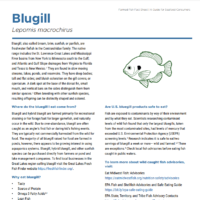
Where do the bluegill I eat come from?
Bluegill and hybrid bluegill are farmed primarily for recreational stocking or for forage/bait for larger gamefish, and naturally occur in the wild. Due to over-abundance, bluegill are often caught as an angler’s first fish or during kid’s fishing events. They are typically not commercially harvested from the wild for food. The majority of all bluegill raised for food are farmed in ponds, however, there appears to be growing interest in using aquaponics systems. Bluegill, hybrid bluegill, and other sunfish species can be purchased directly from farmers or pond and lake management companies. To find local businesses in the Great Lakes region selling bluegill visit the Great Lakes Fresh.
To receive the free download and recipe visit the Purdue Extension’s resource center: The Education Store – Bluegill Farmed Fish Fact Sheet.
Resources:
Hybrid Striped Bass Farmed Fish Fact Sheet, The Education Store
Freshwater Prawn Farmed Fish Fact Sheet, The Education Store
Ask An Expert: What is Aquaculture?, Purdue Extension FNR YouTube Channel
Walleye Farmed Fish Fact Sheet, The Education Store, Purdue Extension’s resource center
Pacific White Shrimp Farmed Fact Sheet, The Education Store
Yellow Perch Farmed Fish Fact Sheet, The Education Store
Tilapia Farmed Fish Fact Sheet, The Education Store
Rainbow Trout Farmed Fish Fact Sheet, The Education Store
American Paddlefish, The Education Store
A Guide to Small-Scale Fish Processing Using Local Kitchen Facilities, The Education Store
Aquaculture Family Coloring Book Development, The Education Store
Channel Catfish, The Education Store
Eat Midwest Fish, Illinois-Indiana Sea Grant online resource hub
Amy Shambach, Aquaculture Marketing Outreach Associate
Purdue Department of Forestry and Natural Resources/Illinois Indiana Sea Grant Program
Seafood is more than just fish caught in the ocean. It includes a wide variety of product types, forms, flavors, and textures. One of the great things about using seafood is its versatility—it can be served as a main course or be used as an ingredient for appetizers, salads, and soups. Packed with important nutrients the human body needs to maintain good health, it is an excellent source of protein to include on your shopping list. Being informed about both the benefits and potential concerns with different types of seafood can help you decide which products to add to your cart or order at a restaurant.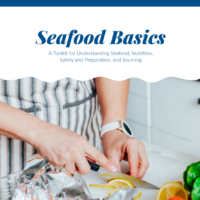
This toolkit, designed specifically for nutrition and wellness professionals and educators, will provide you with information and resources to help you talk to your clients about the complex food category known as seafood. You will learn about the basics of seafood, nutrition benefits of including seafood as part of a healthy eating pattern, concerns about safety, tips for purchasing seafood, and ideas for cooking demonstrations. We’ve included simple and tasty recipes that you can use to introduce your clients to the many flavors of fish and shellfish, links to downloadable and printable handouts, and sample social media posts that you can use to inform and inspire.
This toolkit is geared toward extension staff who teach nutrition and wellness. It includes both printable and digital elements that can be shared with clients based on interest and need.
To receive the free download and recipe visit the Purdue Extension’s resource center: The Education Store – Seafood Basics: A Toolkit for Understanding Seafood, Nutrition, Safety and Preparation, and Sourcing.
Resources:
Purdue Extension – Forestry and Natural Resources– Subscribe to the Youtube channel
Freshwater Prawn Farmed Fish Fact Sheet, The Education Store
Ask An Expert: What is Aquaculture?, Purdue Extension FNR YouTube Channel
Largemouth Bass Market Trends, Purdue Extension – Forestry and Natural Resources (FNR) YouTube Channel
Yellow Perch Farmed Fish Fact Sheet, The Education Store
Tilapia Farmed Fish Fact Sheet, The Education Store
Rainbow Trout Farmed Fish Fact Sheet, The Education Store
American Paddlefish, The Education Store
A Guide to Small-Scale Fish Processing Using Local Kitchen Facilities, The Education Store
Aquaculture Family Coloring Book Development, The Education Store
Channel Catfish, The Education Store
Eat Midwest Fish, Illinois-Indiana Sea Grant online resource hub
Amy Shambach, Aquaculture Marketing Outreach Associate
Purdue Department of Forestry and Natural Resources/Illinois Indiana Sea Grant Program
Hybrid plants and animals can occur in wild environments and are produced by artificially crossing species for the purpose of selective breeding. An example of a popular commercial application is hybrid striped bass, a striped (Morone saxatilis) and white bass (Morone chrysops) cross. Common names include palmetto and sunshine bass. Hybrid striped bass have broken stripes running the length of their bodies, and forked tails. They have two unconnected dorsal fins—one with hard spines. They often are silver above and white below. Coloration depends on environmental factors, like the color of the water. Their flesh has a mild flavor and flakey texture when cooked.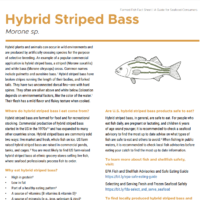
Where do hybrid striped bass I eat come from?
Hybrid striped bass are farmed for food and for recreational stocking. Commercial production of hybrid striped bass started in the US in the 1970s and has expanded to many other countries since. Hybrid striped bass are commonly sold two ways: live market and fresh, whole fish on ice. US farm raised hybrid striped bass are raised in commercial ponds, tanks, and cages. You are most likely to find US farm-raised hybrid striped bass at ethnic grocery stores selling live fish, where seafood professionals process fish to order.
To receive the free download and recipe visit the Purdue Extension’s resource center: The Education Store – Hybrid Striped Bass Farmed Fish Fact Sheet.
Resources:
Freshwater Prawn Farmed Fish Fact Sheet, The Education Store
Ask An Expert: What is Aquaculture?, Purdue Extension FNR YouTube Channel
Walleye Farmed Fish Fact Sheet, The Education Store, Purdue Extension’s resource center
Pacific White Shrimp Farmed Fact Sheet, The Education Store
Yellow Perch Farmed Fish Fact Sheet, The Education Store
Tilapia Farmed Fish Fact Sheet, The Education Store
Rainbow Trout Farmed Fish Fact Sheet, The Education Store
American Paddlefish, The Education Store
A Guide to Small-Scale Fish Processing Using Local Kitchen Facilities, The Education Store
Aquaculture Family Coloring Book Development, The Education Store
Channel Catfish, The Education Store
Eat Midwest Fish, Illinois-Indiana Sea Grant online resource hub
Amy Shambach, Aquaculture Marketing Outreach Associate
Purdue Department of Forestry and Natural Resources/Illinois Indiana Sea Grant Program
Recent Posts
- Virtual Tour Brings Forest Management for Birds to Life
Posted: July 19, 2024 in Forestry, How To, Publication, Wildlife - Publication – Introduction to White-tailed Deer Impacts on Indiana Woodlands
Posted: April 28, 2024 in Forestry, Land Use, Plants, Publication, Wildlife, Woodlands - Publication – Understanding White-tailed Deer and Their Impact on Indiana Woodlands
Posted: in Forestry, Land Use, Plants, Publication, Wildlife, Woodlands - Publication – Monitoring White-tailed Deer and Their Impact on Indiana Woodlands
Posted: in Forestry, Land Use, Plants, Publication, Wildlife, Woodlands - Publication – Managing White-tailed Deer Impacts on Indiana Woodlands
Posted: in Forestry, Land Use, Plants, Publication, Wildlife, Woodlands - New Deer Impact Toolbox
Posted: April 7, 2024 in Forestry, Land Use, Plants, Publication, Safety, Wildlife, Woodlands - Purdue Extension 2023 Impact Report
Posted: February 6, 2024 in Forestry, Land Use, Plants, Publication, Wildlife, Woodlands - Publication- Bluegill Farmed Fish Fact Sheet
Posted: December 15, 2023 in Aquaculture/Fish, Aquatic/Aquaculture Resources, Publication, Wildlife - Publication- Seafood Basics: A Toolkit for Understanding Seafood, Nutrition, Safety and Preparation, and Sourcing
Posted: November 1, 2023 in Aquaculture/Fish, Aquatic/Aquaculture Resources, How To, Publication, Safety - Publication- Hybrid Striped Bass Farmed Fish Fact Sheet
Posted: October 9, 2023 in Aquaculture/Fish, Aquatic/Aquaculture Resources, Publication, Wildlife
Archives
Categories
- Alert
- Aquaculture/Fish
- Aquatic/Aquaculture Resources
- Ask the Expert
- Christmas Trees
- Community Development
- Disease
- Drought
- Forestry
- Forests and Street Trees
- Gardening
- Got Nature for Kids
- Great Lakes
- How To
- Invasive Animal Species
- Invasive Insects
- Invasive Plant Species
- Land Use
- Natural Resource Planning
- Nature of Teaching
- Plants
- Podcasts
- Ponds
- Publication
- Safety
- Spiders
- Timber Marketing
- Uncategorized
- Urban Forestry
- Webinar
- Wildlife
- Wood Products/Manufacturing
- Woodland Management Moment
- Woodlands

